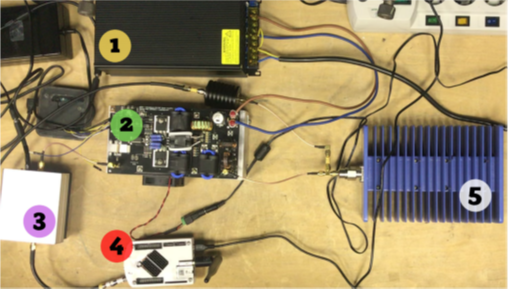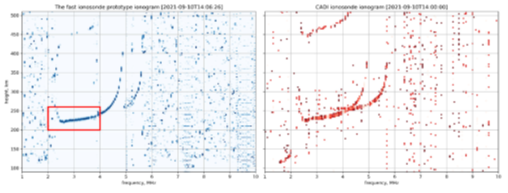SDR-based Fast Vertical Ionosonde prototype
-
Posted by
 Red Pitaya Team
, February 17, 2022
Red Pitaya Team
, February 17, 2022

FPGAs have been playing an increasing role in the development of Software-Designed-Radio, making projects simpler and cheaper thanks to COTS components. Red Pitaya is no stranger to this development and has actually created a specific model for this purpose: the SDRlab 122-16, with increased 16-bit ADC and 14-bit DAC resolution, and a sampling rate of 122.88 MS/s.
In their newly published article, “The Prototype of a Fast Vertical Ionosonde Based on Modern Software-Defined Radio Devices”, A.V. Shindin et al. demonstrate how this technology makes the monitoring of HF radio wave reflection in the ionosphere – by implementing chirp ionosondes – accessible to low-to-medium-budget projects. The general concept is no novelty, since ionograms have been generated since the 1920s, using traditional RF equipment for vertical sounding of the ionosphere with short coded pulses. The new prototype also uses an HF radar station to emit the same type of pulses, with a filling frequency between 1 and 20 MHz, which are then reflected by the ionosphere, captured by a receiver, recorded and processed, resulting in a height-frequency graph which quantifies the electron concentration profile over an altitude range of 80 – 700 km.
The emitter uses a traditional CADI ionosonde, upgraded with modern components. In a classic setup, this ionosonde obtains a higher signal-to-noise ratio by averaging its measurements over four pulses at the same frequency, resulting in a sweep time of 40 seconds and an additional processing time of one minute, with a height resolution of 3 km.
 Figure 1
Figure 1
Figure 1 shows the transmitter part of the ionosonde prototype, including an amplifier power supply (1), linear amplifier A600 (2), 5 W preamplifier (3), Red Pitaya SDRlab 122-16 in a 3D-printed case as a master oscillator, or probe pulse generator (4), and a matched load (5).
The receiver part is based on a two-channel SDR device, with modified upconverters to filter the HF signal and move it to the 120-130 MHz range, and a low-noise amplifier for the input signal.
Besides the smaller and cheaper hardware, user-friendly software is also key in determining the functionality and purpose of the devices. In this specific case, the open-source packages and the dynamic Red Pitaya user community makes the SDRlab configuration extremely straightforward and very effective with regard to functionality and operating speed. To obtain fast ionograms, the pulse repetition period was reduced from 25 to 5 ms, the averaging of the received signal was eliminated, and the frequency sweep range limited to 10 MHz, resulting in real-time ionogram recording and sounding times of 0.9 s (making it almost instant, compared to the former one-minute processing time). The height resolution was improved, using a GNU radio framework for the software to record ionograms, reaching a 1.5 km accuracy. Moreover, it was possible to run the entire process on a standard quad-core laptop.
The test results obtained with the prototype have shown that it can withstand continuous 24h-operation. Test runs with different types of antenna have shown that the best results were obtained with a large diagnostic transmitting/receiving antenna (in-phase horizontal antenna array 126 x 126 m, suspended on 16m-high masts) with three resonant frequencies (2.95, 4.6 and 5.7 MHz). Figure 2 shows comparative results between the fast ionosonde prototype and the classic CADI-setup with this antenna.
 Figure 2
Figure 2
The article demonstrates that ionograms can be generated with significantly shorter cycle times (seconds vs. minutes), allowing the monitoring of fast ionospheric movements. Not only is this setup faster, but thanks to its off-the-shelf components it can also be carried out on a budget which is at least one order of magnitude smaller than previously possible. Naturally, there is always room for improvement. A future version will allow the SDRlab 122 to play an even bigger role in such tasks, by also implementing it in the receiver setup, which will further reduce the overall cost of the resulting system.
About the Red Pitaya Team
The Red Pitaya editorial team consists of engineers, researchers, and product experts who develop and test cutting-edge open-source test & measurement solutions.
Our mission is to make advanced instrumentation accessible to everyone — from students and educators to leading research labs worldwide.



